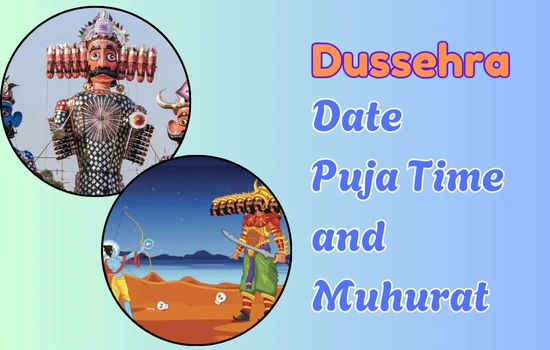Dussehra, also known as Vijayadashami, is a significant Hindu festival symbolizing the triumph of good over evil. It commemorates Lord Rama’s victory over the demon king Ravana and Goddess Durga’s conquest of Mahishasura. In 2025, Dussehra falls on Thursday, October 2.
Key Timings for Dussehra 2025

1. Dashami Tithi:
- Begins: 7:01 PM on October 1, 2025
- Ends: 7:10 PM on October 2, 2025
2. Vijay Muhurat:
- Time: 2:09 PM to 2:56 PM on October 2, 2025
- Duration: 47 minutes
3. Aparahna Puja Time:
- Time: 1:21 PM to 3:44 PM on October 2, 2025
- Duration: 2 hours and 23 minutes
These timings are based on Indian Standard Time (IST) and may vary slightly depending on your location. It’s advisable to consult local sources or a reliable Panchang for precise timings.
Significance of Dussehra
Dussehra marks the culmination of the nine-day Navratri festival and signifies the victory of righteousness over evil forces. In northern India, it celebrates Lord Rama’s defeat of Ravana, while in eastern regions, it denotes Goddess Durga’s victory over the buffalo demon Mahishasura. The festival underscores the importance of moral values, courage, and the perpetual battle between good and evil.
Rituals and Celebrations
1. Aparajita Puja: Performed during the Aparahna period, this ritual seeks the blessings of Goddess Aparajita for victory and prosperity. Devotees offer prayers and perform rituals to invoke the goddess’s favor.
2. Shami Puja: The Shami tree holds special significance on Dussehra. Devotees worship the tree, seeking blessings for success and prosperity. In some traditions, leaves from the Shami tree are exchanged as symbols of goodwill.
3. Seema Avalanghan (Crossing the Border): This ritual involves symbolically crossing the boundaries of one’s home or village, signifying the conquest of new territories and the expansion of horizons. It is traditionally performed by warriors and is associated with valor and courage.
4. Ramlila and Ravana Dahan: Dramatic enactments of the Ramayana, known as Ramlila, are performed, culminating in the burning of effigies of Ravana, Meghnath, and Kumbhkaran. This symbolizes the eradication of evil and the reaffirmation of virtuous living.
5. Durga Visarjan: In regions where Durga Puja is predominant, idols of Goddess Durga are immersed in water bodies, marking her return to her celestial abode. This ritual signifies the cyclical nature of life and the goddess’s promise to return each year.
Cultural Variations
1. Northern India: Dussehra is marked by large fairs, Ramlila performances, and the burning of massive effigies of Ravana, symbolizing the victory of good over evil. Communities come together to witness these events, fostering a sense of unity and shared cultural heritage.
2. Eastern India: The festival coincides with the conclusion of Durga Puja. Elaborate rituals, cultural performances, and processions are held, culminating in the immersion of Durga idols. The celebrations are characterized by artistic expression, devotion, and communal harmony.
3. Southern India: Known as Dasara, especially in Karnataka, the festival is celebrated with grandeur, including processions, cultural events, and the worship of deities. The Mysore Dasara is particularly famous for its royal procession and cultural festivities.
Astrological Perspective
Performing rituals during the Vijay Muhurat is considered highly auspicious, as it is believed to enhance the efficacy of prayers and bring success in endeavors. The alignment of celestial bodies during this period is thought to favor the triumph of good forces.
Conclusion
Dussehra 2025, observed on October 2, serves as a reminder of the eternal victory of good over evil. Engaging in the prescribed rituals during the specified muhurat is believed to invoke divine blessings, ensuring prosperity, success, and the removal of obstacles. As you prepare to celebrate this auspicious festival, may the spirit of Dussehra inspire you to uphold righteousness and lead a life of virtue.

